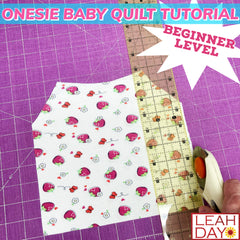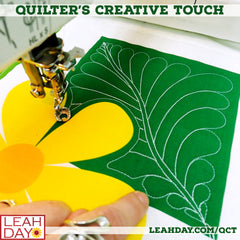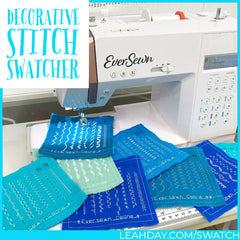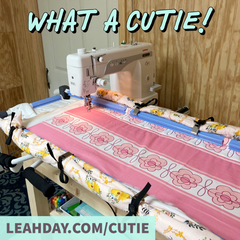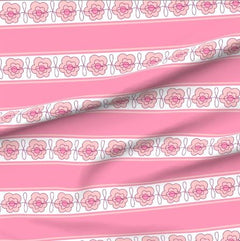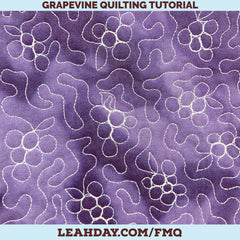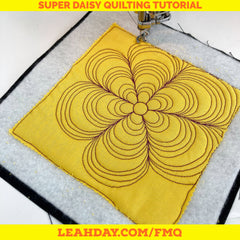Welcome back to the Prism Path baby quilt along! We’re piecing AND quilting together to make pretty rainbow baby quilt. This week we’re finally ready to machine quilt a super simple design over the surface.
Learn how to quilt straight lines with walking foot quilting in this quilting tutorial video:
Where do you find the instructions for piecing this pretty rainbow baby quilt? Find the cutting chart, diagrams, and everything you need to make your own Prism Path quilt in the book Explore Walking Foot Quilting with Leah Day.
Pull Out Your Bobbins!
I decided to quilt Prism Path with a straight line stitched over each color in the rainbow section and to change thread color with each line of quilting. So I stitched red thread over the red squares, orange over the orange and so on.
To prepare for this quilting adventure, I wound one bobbin of each thread color, and three bobbins of white, which is the background color I’m using over the black fabric to quilt Matrix next week.
It saves a lot of time and hassle to go on a head and wind your bobbins before you begin quilting.
But wait – red on the front AND back? Won’t that make the back look weird?

I think this makes the back of the quilt look even better! I used my heart medallion fabric on the back of this quilt and the shots of different colors over the printed medallion designs looks great.
If you try to match thread to the back, you’ll end up with one color in your bobbins and another color in the top of the machine. This is a recipe for head-banging-on-the-wall frustration. No machine has perfect tension all the time. It simply doesn’t work that way.
All home sewing machines fluctuate. Sometimes the thread catches on the spool a bit and the tension will tighten on the top, then it pulls a loose loop and the bobbin thread will suddenly pull it to the back of the quilt.
Rather than fight with your tension dial, save yourself a host of headaches and heartbreak and simply match the same color thread on the top and in the bobbin of your machine.
Quilting from the Center
Machine quilting on a home sewing machine has one basic rule: quilt from the center. When you begin in the center and stitch outwards, you’re moving from an area that feels hard to an area that feels much easier.
This also allows any excess batting or fabric to shift outward too. No matter how securely you baste the quilt, it may still shift a bit as you stitch it on your home machine. By quilting from the center to the outer edges, the fabric can move if it wants to and it won’t be a problem.
If you quilted in the other direction, from the outer edges to the inside, you risk stitching pleats into the quilt. If there’s excess fabric puddled up in the center and you stitch over it, chances are that fabric is going to move, then hit another line of quilting, and like a pile of snow hitting a snow bank, it will flow over the line and form a pleat.

It’s also just plain logical to quilt from the center of the quilt because it feels progressively easier with each line of quilting you stitch.
Quilting One Color at a Time
I am relatively lazy and I really don’t like to change my bobbins unless I absolutely have to. When quilting the Prism Path quilt, strictly I should have started in the center and changed thread to quilt each line of the center-most rainbow sections first, then quilted along the outer areas.
But let’s live in reality! I don’t have time to change thread colors that often!

So instead when I had red thread in the machine I knocked out ALL the spaces I was quilting with red.
Yes, even if this meant I was securing a few lines further from the center.
The thing to keep in mind is how dense the design is on any particular quilt. If I was quilting the snot out of Prism Path with dense free motion filler designs, sure, I would need to work steadily from the center.
But this quilt is generally being quilted on a 2 inch scale (2 inches between all the lines of quilting) and I know I can get away with this.
Mostly because I already did!
So when quilting the straight lines with matching colors of threads, you can quilt all the lines you need with one color before changing to the next color. Knock out all the lines of red, then orange, then yellow and so on so you only have to change the bobbin thread 7 times for this quilt.

Don’t forget to change to white at the very end and quilt along the straight lines on either side of the rainbow Prism areas. These lines are useful for creating a visual separation between the background and the rainbow areas. You don’t HAVE to quilt them though so think about it and If you like the look of your quilt without the white straight lines, don’t quilt those lines.
Prism Path Quilting Homework
Your homework this week is to quilt all of the straight lines over the rainbow prism area on the Prism Path quilt. You can save some time by winding all the bobbins ahead of time so it's easy to pop one in and quilt all of the lines in that color of thread.
Next week we will finish up the Prism Path quilt by quilting Matrix in the background! Click Here to join in the fun and find this Bargello quilt pattern in the book Explore Walking Foot Quilting with Leah Day.
Let's go quilt,
Leah Day
Find all of the posts for this baby quilt along by clicking the images below!



